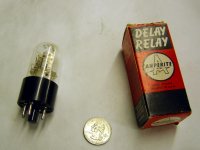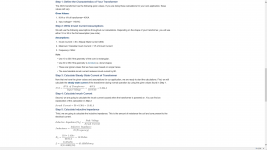Hi,
I use an Amperite 6NO30 time delay tube to switch a relay (230 Volt coil) in order to switch 230 Volt with higher current. When the Amperite’s 30 seconds have passed, the contacts make contact and I notice the relay rattles shortly before contact is 100%. Small sparks are visible between the contacts. The reason is that the actual contact is made quite slowly. I’m now trying to rectify the 230 Volt AC for the relay, with a small capacitor, to get the relay switching better/faster.
Any other suggestions for improvement?
Regards, Gerrit
I use an Amperite 6NO30 time delay tube to switch a relay (230 Volt coil) in order to switch 230 Volt with higher current. When the Amperite’s 30 seconds have passed, the contacts make contact and I notice the relay rattles shortly before contact is 100%. Small sparks are visible between the contacts. The reason is that the actual contact is made quite slowly. I’m now trying to rectify the 230 Volt AC for the relay, with a small capacitor, to get the relay switching better/faster.
Any other suggestions for improvement?
Regards, Gerrit
Attachments
Last edited:
The contacts are rated at 3A, 115VAC. You are using it at twice its voltage rating.
https://datasheet.octopart.com/6NO30-Amperite-datasheet-8551060.pdf
https://datasheet.octopart.com/6NO30-Amperite-datasheet-8551060.pdf
Last edited:
Hi, I rectified the (230 volt) AC relay voltage, using a 1K resistor in series with a 1000 volt diode charging a small 2.2 uF capacitor. This gives me around 185 Volts, what is fine for my 230 Volt relay. Switching this voltage is now without any sparks, without rattling.
I use one of the relay contacts so switch off the Amperite 6.3 Volts heater and another relay contact to keep the relay powered. These additions will switch off the Amperite delay approx. 20 seconds after it’s switching on. When the main power is switched off and on again, the Amperite delay has been “reset” this way and will again use the 30 seconds delay.
Regards, Gerrit
I use one of the relay contacts so switch off the Amperite 6.3 Volts heater and another relay contact to keep the relay powered. These additions will switch off the Amperite delay approx. 20 seconds after it’s switching on. When the main power is switched off and on again, the Amperite delay has been “reset” this way and will again use the 30 seconds delay.
Regards, Gerrit
Hi, I rectified the (230 volt) AC relay voltage, using a 1K resistor in series with a 1000 volt diode charging a small 2.2 uF capacitor. This gives me around 185 Volts, what is fine for my 230 Volt relay. Switching this voltage is now without any sparks, without rattling.
I use one of the relay contacts so switch off the Amperite 6.3 Volts heater and another relay contact to keep the relay powered. These additions will switch off the Amperite delay approx. 20 seconds after it’s switching on. When the main power is switched off and on again, the Amperite delay has been “reset” this way and will again use the 30 seconds delay.
Regards, Gerrit
Hallo Gerrit
I am going to use a similar relay - I assume you want a soft start after the tubes' filaments have warmed up.
I have worked out what to use on the primary winding as NTC's and am going to use a 6NO60 instead. I will use three 200D9 NTC's in series with the primary winding of a 80 Watt mains transformer @ 240V. Short NTC's after 60 seconds and the filaments will have about 5V while cold and when the tubes start to heat up then the NTC's start to loose their resistance and the HT gets higher. After 60 seconds the delay relay will come on to short the NTC's so ensuring that they are cool when the amplifier gets restarted. I've calculated that there will be not more than about 30V across the NTC once they've heated up.
I did something similar with an amplifier I build in the ast and it worked fine - the filaments did not suddenly light up like a light bulb and HT was limited at startup.
By the way: the delay relay is rated at 115VAC and only 30V DC.
Met vriendelijke groet vanuit Nieuw Zeeland.
Attachments
Last edited:
A lot of time was spend researching NTC use.
I've attached a few screengrabs from Ametherm that I used for NTC calculations. Epcos remarked that NTC's have to work between 30% and 10% of its capacity.
Just note that NTC's from different manufacturers have different current ratings for the same size. Check the spec' sheets!
In my case I checked the current rating and based the resistance on the amount of voltage drop that I wanted in order to prevent the filaments lighting up and the HT going above the 300VDC (the driver tubes had that as a maximum cold rating).
Enjoy!
I've attached a few screengrabs from Ametherm that I used for NTC calculations. Epcos remarked that NTC's have to work between 30% and 10% of its capacity.
Just note that NTC's from different manufacturers have different current ratings for the same size. Check the spec' sheets!
In my case I checked the current rating and based the resistance on the amount of voltage drop that I wanted in order to prevent the filaments lighting up and the HT going above the 300VDC (the driver tubes had that as a maximum cold rating).
Enjoy!
Attachments
Last edited:
- Home
- Amplifiers
- Tubes / Valves
- 6NO30 Amperite time delay


